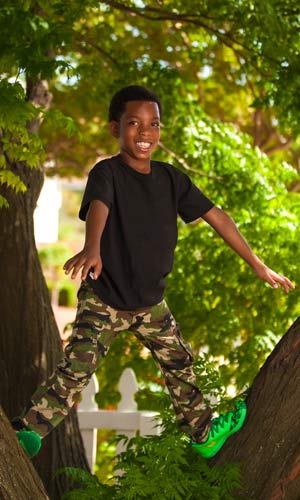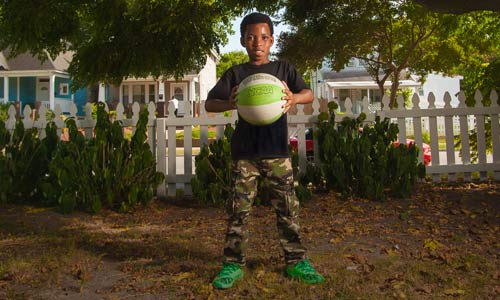 On a warm spring day in March, Sofia Jones and her 7-year-old son, Nasair, walked to the park near their house in Norfolk to play with friends. Not long after they arrived, their world changed.
On a warm spring day in March, Sofia Jones and her 7-year-old son, Nasair, walked to the park near their house in Norfolk to play with friends. Not long after they arrived, their world changed.
In a flash, Nasair was in the street, motionless on the asphalt, after the impact of an SUV. Sofia knelt beside him in shock, whispering words of comfort and waiting for the ambulance to arrive. “He was barely conscious, but I know he heard my voice,” she says.
When Nasair arrived at CHKD, a team of pediatric specialists and surgeons immediately assessed his serious injuries: a broken leg, arm and shoulder blade; deep abrasions along the left side of his body; a fractured eye socket and a collapsed lung. Nasair was in critical condition.
As a hospital chaplain comforted Sofia, Dr. John Birknes, a pediatric neurosurgeon, inserted an intracranial pressure monitor in Nasair’s skull to check his brain for swelling. Dr. George Hoerr, a pediatric plastic surgeon, examined his fractured eye socket and sutured a major laceration on his forehead.
Nasair spent the following two days in CHKD’s pediatric intensive care unit (PICU) before he was stable enough for surgery on the severely fractured femur bone in his left leg. Dr. Allison Crepeau, one of seven pediatric orthopedic surgeons at CHKD, set the fractures in Nasair’s arm and shoulder blade and operated on his leg using a special technique to avoid disrupting his growth plate.
“Children break their bones differently than adults, and we have to fix them differently,”says Dr. Crepeau. “Adult hospitals don’t have the pediatric equipment we have at CHKD to operate on children with these kind of fractures. When a child in Hampton Roads has this kind of injury, hospitals send them to CHKD.”
To repair Nasair’s broken leg, Dr. Crepeau made one-inch incisions on either side of his knee and, careful to avoid the growth plate, threaded two flexible titanium nails into the middle of the bone. With X-ray guidance, she guided the nails – resembling thin wires – across the fracture site in a crisscross pattern, serving as an internal splint for the bone as it healed. The nails would be removed during a follow-up surgery once the bone mended.
After a week recovering from surgery, Nasair was admitted to CHKD’s inpatient rehabilitation unit, the only pediatric unit of its kind in the state of Virginia. This unique program helps children who need intense physical, occupational and speech therapies before they are ready to transition to an outpatient rehabilitation routine.
Nasair would spend nearly three weeks in the rehabilitation unit at CHKD, completing at least three hours of intensive therapy a day, six days a week. “His was a really difficult injury because the trauma was so extensive on one side of his body,” says Dr. Rianna Leazer, medical director of inpatient rehabilitation at CHKD. “The inability to use an arm or a leg to support the left side of his body made balance and mobility an extra challenge.”
Dr. Leazer is one of seven CHKD hospitalists – specialists in caring for hospitalized children with acute or chronic health problems. Hospitalists collaborate with CHKD’s rehabilitation program medical director, Dr. Katrina Lesher, along with child life specialists, pediatric therapists and nutritionists to provide care on the unit. Everything in the program, from equipment to therapy exercises, is designed specifically for children to help them recover from traumatic injuries, surgery or a debilitating illness.
“For example, children can play board games to help their arms start to move,” Dr. Leazer says. “They can play flash card games to work on proper eye movement. You might see kids playing with a Wii, riding in toy cars or using pop-up toys to gain strength in their hands. We distract them to get them to do the work they need to do. We make it fun, which is essential to helping kids heal.”
 The rehabilitation unit works to create a comfortable, safe and productive environment, allowing children to take part in as many of their normal activities as possible. CHKD’s hospital school program partners with each patient’s home school and provides teachers in the hospital to keep kids on track academically. The rehab unit features a common room where patients can socialize, listen to stories, play games and eat meals together. A parent is welcome to stay overnight in a child’s room, and family members are encouraged to be part of the child’s care team.
The rehabilitation unit works to create a comfortable, safe and productive environment, allowing children to take part in as many of their normal activities as possible. CHKD’s hospital school program partners with each patient’s home school and provides teachers in the hospital to keep kids on track academically. The rehab unit features a common room where patients can socialize, listen to stories, play games and eat meals together. A parent is welcome to stay overnight in a child’s room, and family members are encouraged to be part of the child’s care team.
“It’s incredibly rewarding work,” Dr. Leazer says. “Some kids come in barely able to move, and by the end of their rehabilitation, they’re walking out on their own. This can be a very rigorous program for a child. But with an intensive approach – pushing them hard but not too hard – we can see improvements very quickly.”
While any movements were difficult at first, Nasair was walking with assistance six weeks after his accident. By the end of June, he was taking steps on his own. “He is a very lucky little boy and has healed amazingly well,” Dr. Crepeau says. “He should have no lingering issues from the accident.”
Sofia credits CHKD with saving Nasair’s life. “CHKD is an amazing hospital,” she says. “Everyone was wonderful – from the doctors and nurses who helped him in the PICU to those in the rehabilitation unit,” says Sofia. “Today, Nasair is back to being himself.”